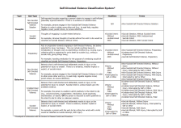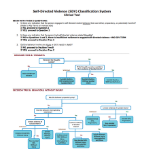MIRECC / CoE
Self-Directed Violence (SDV) Classification System
 |
|||
 |
 |
 |
 |
Self-Directed Violence (SDV) Classification System and Clinical Toolkit
Self-directed violence, or SDV, encompasses a wide range of thoughts and behaviors that may or may not reflect suicidal intent. Historically, there has been a lack of universally agreed-upon terms to describe the spectrum of thoughts and behaviors that fall under the larger umbrella of self-directed violence. A shared understanding of SDV in its various forms is critical. A common nomenclature can help improve communication and outcomes in multiple ways, including:
- Tracking individual risk in patient care settings
- Implementing system-wide suicide prevention strategies
- Designing clinical research to inform evidence-based practices
The Rocky Mountain MIRECC developed the Self-Directed Violence Classification System (SDVCS) in collaboration with the Centers for Disease Control (CDC). This classification system is consistent with the CDC Self-Directed Violence Surveillance Uniform: Definitions and Recommended Data Elements. Both the Department of Veterans Affairs (VA) and the Department of Defense have adopted the use of the SDVCS.
The Rocky Mountain MIRECC developed two tools to help others learn and use the SDVCS:
 |
Downloadable SDVCS Table NOTE: The SDVCS Table is currently unavailable to download while we improve the accessibility. Thanks for your patience and we apologize for the inconvenience. Please email us at SRMConsult@va.gov to request a copy. This SDVCS Table provides detailed definitions to promote consistent and precise use of the SDVCS. These definitions help classify suicidal thoughts and behavior in a way that is comprehensive (i.e., all thoughts and behaviors can be classified) while also mutually exclusive (i.e., each thought or behavior falls into only ONE classification). |
 |
Downloadable SDVCS Clinical Tool NOTE: The SDVCS Clinical Tool is currently unavailable to download while we improve the accessibility. Thanks for your patience and we apologize for the inconvenience. Please email us at SRMConsult@va.gov to request a copy. The SDVCS Clinical Tool can be used by providers to enhance their suicide risk assessment, which can guide treatment. The easy-to-use SDVCS decision tree facilitates rapid SDV term identification. |
No-cost print versions of the SDVCS Table and Clinical Tool REMAIN AVAILABLE and may be ordered here.
5 Vignettes for SDVCS Training
To guide the implementation of the SDVCS into practice, we offer five training vignettes that present clinical situations and, with the help of a consultant, lead the clinician through the SDVCS. If you have an SDVCS question or would like to discuss the SDVCS please email us at SRMConsult@va.gov.
SDVCS Introduction with Bridget Matarazzo, PsyD (6 min)
Dr. Matarazzo explains clearly why the adoption of the Self-Directed Violence Classification System is important for clinical practice and research related to suicide prevention.
SDVCS Vignette 1: "Going to Bed and Not Waking Up" (5 min)
The clinician meets with a Veteran who says she is “down” and hasn’t been getting out of the house much. The clinician asks directly, "Have you been having any thoughts of suicide or killing yourself?" The Veteran gives an ambiguous answer, and a consultant helps identify the SDVCS term.
SDVCS Vignette 2: "I'm Done" (8 min)
The clinician meets with a young Veteran who has had a recent suicide attempt. The consultant explores the issues of determining suicidal intent, bodily injury, and what is meant by “interrupted by self or other.”
SDVCS Vignette 3: "Can We Determine Suicidal Intent?" (6 min)
A Suicide Prevention Coordinator (SPC) reaches out to a Veteran who has missed a recent appointment. As the SPC checks in with her, the Veteran brings up burning her arm with a cigarette. In the following consultation session, the clinician is faced with determining intent and how to classify a specific behavior through the lens of the SDVCS.
SDVCS Vignette 4: "Asking Three Questions to Determine Suicidal Intent" (8 minutes)
The Veteran is dealing with chronic pain from a back injury. One night he searches for information on how to overdose on pain medication. The clinician and the consultant explore what makes a behavior preparatory and what is suicidal intent when it comes to preparatory behavior.
SDVCS Vignette 5: "Interrupted by Self or Other" (7 min)
An older Veteran who is feeling overwhelmed by health issues and a pending divorce decides to drive his car into a ditch to end his life. Before he can act, he is stopped for careless driving. The clinician and consultant unpack all that happens in this session before deciding on the SDVCS term.
Additional SDVCS Training Resources
Online SDVCS Training Videos
- Watch this video, narrated by Dr. Lisa Brenner, for a brief online training on the SDVCS. This was part of a series of presentations for mental health providers who work with Veterans. Dr. Brenner explains the purpose and development of the SDVCS, defines the components of suicidal intent, and works through case examples with the audience using the SDVCS Clinical Tool.
- Watch the Self-Directed Violence Classification System (SDVCS) recording from the Suicide Risk Management Lecture Series. This webinar focuses on using the SDVCS. Dr. Ryan Holliday provides the rationale for using universal terminology to assess and document all aspects of self-directed violence. This presentation walks viewers through using the SDVCS and shows how to troubleshoot risk classification difficulties to inform treatment decision-making.
SDV Training Quiz
Test your Self-Directed Violence Classification System knowledge by reviewing 10 vignettes and answering 28 SDV related questions. (Temporarily unavailable)
PowerPoint Training for Self-Directed Violence - Updated November 2018
This presentation contains the most comprehensive training information on the SDVCS. NOTE: The SDVCS Training Slides are currently unavailable to download while we improve the accessibility. Thanks for your patience and we apologize for the inconvenience. Please email us at SRMConsult@va.gov to request a copy.
SDV Online Decision Tree
This online version of the SDV decision tree to help clinicians/investigators select the most appropriate SDV term. The tool, based on work by Donald "Gordy" Gordon, offers a quick and easy question-based tree.
Access the SDV On-line Decision Tree Classification Tool.
We'd Like Your Feedback
If you have used the SDVCS we'd like your feedback so we can make the tool better. Please email us at SRMConsult@va.gov.
Last Updated 8 April 2025



















